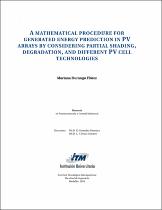Mostrar el registro sencillo del ítem
A mathematical procedure for generated energy prediction in PV arrays by considering partial shading, degradation, and different pv cell technologies
| dc.contributor.advisor | González Montoya, Daniel | |
| dc.contributor.advisor | Trejos Grisales, Luz Adriana | |
| dc.contributor.author | Durango Flórez, Mariana | |
| dc.contributor.author | González Montoya, Daniel | |
| dc.contributor.author | Trejos Grisales, Luz Adriana | |
| dc.date.accessioned | 2023-08-15T19:57:59Z | |
| dc.date.available | 2023-08-15T19:57:59Z | |
| dc.date.issued | 2023 | |
| dc.identifier.uri | http://hdl.handle.net/20.500.12622/6017 | |
| dc.description.abstract | This document describes the development of a mathematical procedure to quantify the power loss in photovoltaic (PV) arrays, considering different technologies (i.e. mono-crystalline, poly-crystalline, and half-cell), partial shading patterns, and degradation types (i.e. soiling, exposure time and hot-spot). For this, a classification of different degradation types is performed to choose the appropriate degradation type for the experimental tests. For the impact of shading on the power generated, experimental tests were carried out with different shading patterns whereby a percentage of power loss was obtained regarding the different shading patterns studied based on the total solar radiation conditions. From the results, it was obtained that the diagonal shading pattern generates the least amount of power loss with a fill factor of 0.807 and a percentage of lost power of 19.216%. With the experimental tests performed in which different degradation test scenarios were taken into account, different mathematical methods were used with the collected data: a genetic algorithm for parameter estimation based on the single diode model (SDM) fromthe experimentally obtained curves, then an analyticalmethod based on the Lambert W function for the calculation of the SDM parameters using the datasheet values of each PV panel under study to emulate a healthy PV panel, and the last method was a brute force using a Newthon- Raphson with which an additional parameter (δ) was introduced to quantify the loss of the power supplied by the change in the parameters of series resistance Rs and shunt resistance Rsh. The results obtained from the methods described previously applied to the three PV panels under study are analyzed and it can be deduced that under the study conditions (i.e. soiling and no-soiling), the half-cell technology has the lowest power loss with 26.34% with respect to the P-V curve obtained of the healthy PV. In turn, the quantification of power loss for the degradation test scenarios also showed that the half-cell technology has the lowest power loss at 27.55%. This procedure presents a method to give versatility to the calculation of PV modeling and PV array sizing since it considers the major causes of power loss, i.e., shading and degradation, and how they affect each PV technology. | spa |
| dc.format.mimetype | application/pdf | spa |
| dc.language.iso | eng | spa |
| dc.rights.uri | http://creativecommons.org/licenses/by-nc-nd/4.0/ | spa |
| dc.subject | Modelos fotovoltaicos | spa |
| dc.subject | Degradación | spa |
| dc.subject | Panel PV | spa |
| dc.subject | Tecnologías fotovoltaicas | spa |
| dc.subject | Patrones de sombreado parcial | spa |
| dc.subject | Métodos numéricos | spa |
| dc.title | A mathematical procedure for generated energy prediction in PV arrays by considering partial shading, degradation, and different pv cell technologies | spa |
| dc.publisher.faculty | Facultad de Ingenierías | spa |
| dc.subject.keywords | Photovoltaic models | spa |
| dc.subject.keywords | Degradation | spa |
| dc.subject.keywords | PV panel | spa |
| dc.subject.keywords | Photovoltaic technologies | spa |
| dc.subject.keywords | Partial shading patterns | spa |
| dc.subject.keywords | Numerical methods | spa |
| dc.subject.lemb | Energía solar | spa |
| dc.subject.lemb | Celulas fotovoltáicas | spa |
| dc.subject.lemb | Algoritmos genéticos | spa |
| dc.subject.lemb | Distribución (Teoría de probabilidades) | spa |
| dc.subject.lemb | Células solares | spa |
| dc.source.bibliographicCitation | Laura Herrera, Alina Miranda, Eliana I. Arango, Carlos A. Ramos-Paja, and Daniel Gonzalez. Dimensionamiento de sistemas de generación fotovoltaicos localizados en la ciudad de medellín. TecnoLógicas, pages 289–301, 2013. | spa |
| dc.description.degreename | Magíster en Automatización y Control Industrial | spa |
| dc.identifier.instname | instname:Instituto Tecnológico Metropolitano | spa |
| dc.identifier.reponame | reponame:Repositorio Institucional Instituto Tecnológico Metropolitano | spa |
| dc.identifier.repourl | repourl:https://repositorio.itm.edu.co | spa |
| dc.rights.local | Acceso abierto | spa |
| dc.rights.accessrights | info:eu-repo/semantics/openAccess | spa |
| dc.rights.creativecommons | Attribution-NonCommercial-NoDerivatives 4.0 International | spa |
| dc.relation.citationissue | TecnoLógicas | spa |
| dc.type.local | Tesis de maestría | spa |
| dc.type.coar | http://purl.org/coar/resource_type/c_bdcc | spa |
| dc.type.driver | info:eu-repo/semantics/masterThesis | spa |
| dc.description.degreelevel | maestría | spa |




